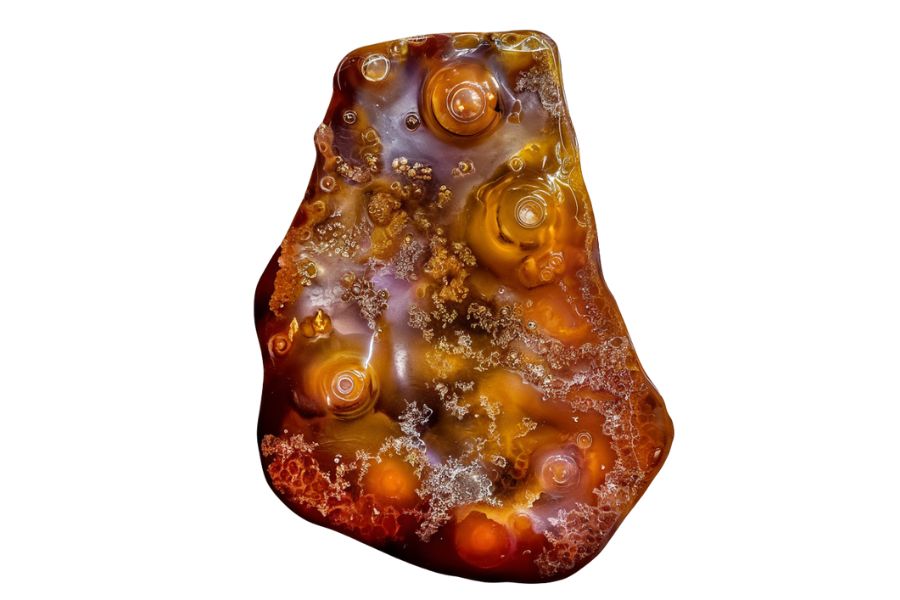The mesmerizing flash of red, orange, and gold in a fire agate can stop any rockhound in their tracks. California’s deserts hold these stunning gems, waiting to be discovered by those willing to look for them.
Many people think you need to be a pro to find these beauties, but that’s not true. With a bit of know-how and the right spots, anyone can uncover these natural treasures.
So, if you’re ready to try your luck at finding these beautiful stones, California has several spots where you can find fire agate.
You’ll get everything you need here to track them down, and the only other thing that truly helps is Rock Chasing’s California Rocks & Minerals Identification Field Guide.
It keeps you from walking past something valuable without realizing it, and it makes it easier to understand what you’ve actually found. Let’s explore some of the best places where you might strike it lucky.
How Fire Agate Forms Here
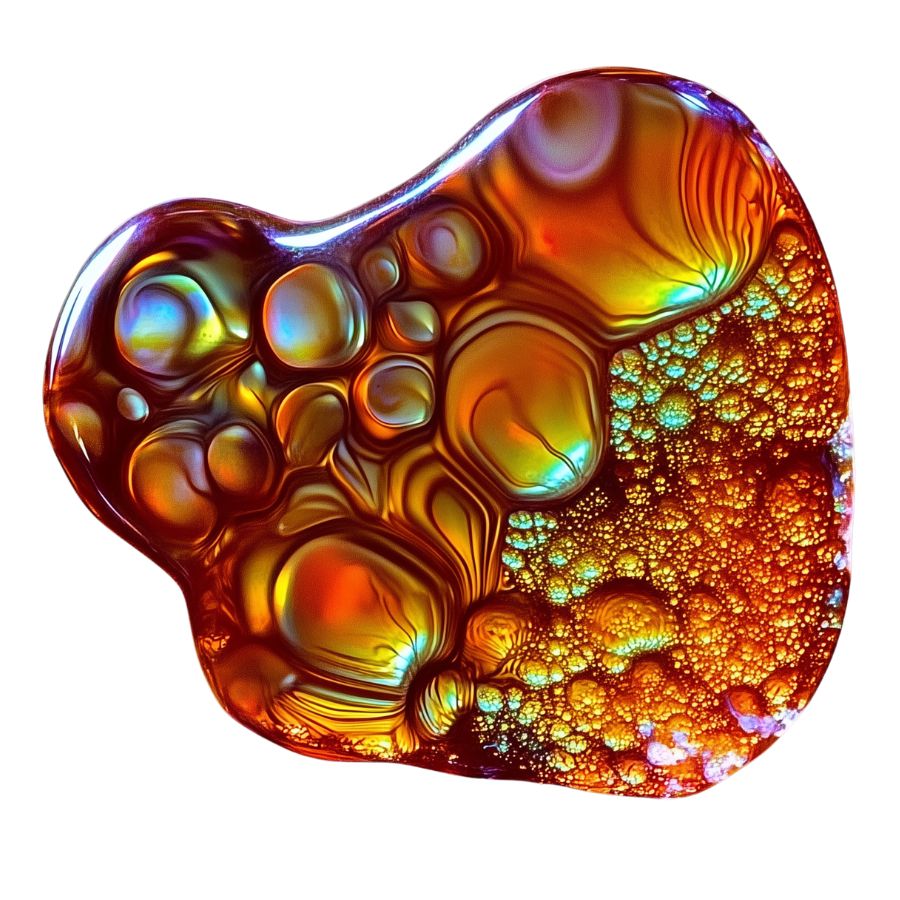
Fire Agate forms when silica-rich fluids seep into layers of chalcedony during volcanic activity. As these fluids cool down, they create super-thin layers of iron oxide and silica, kind of like stacking colorful sheets of plastic.
The iron oxide creates those beautiful iridescent colors you see – reds, oranges, and browns that seem to dance when you move the stone.
What’s really cool is that these layers are only about 0.5 microns thick (that’s thinner than a human hair!).
The more layers there are, the more intense the fire effect becomes. The whole process happens deep underground where hot water and minerals mix together over millions of years.
Types of Fire Agate
Fire agates represent nature’s artistry at its finest, showcasing spectacular plays of color that seem to dance within the stone. Each variety offers its own unique display of iridescent fire effects, created through millions of years of geological processes that layered minerals in distinctive patterns.
Brown Fire Agate
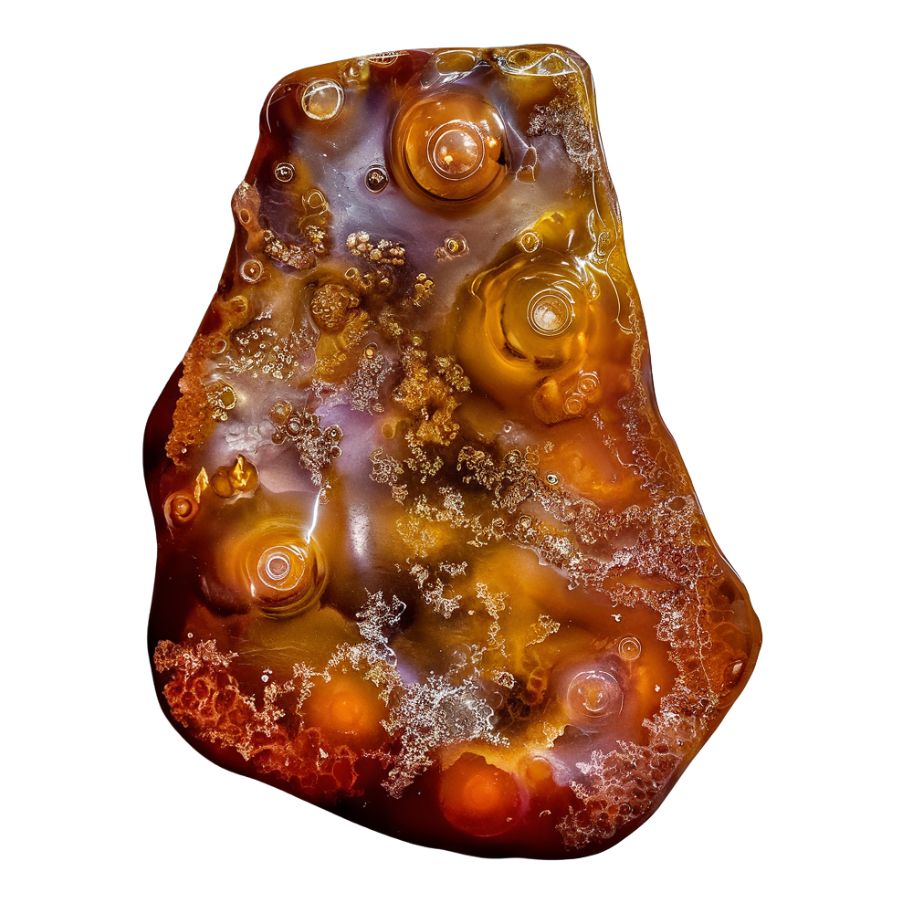
Brown Fire Agate displays a deep chocolate-brown base with brilliant flashes of color that dance across its surface. The most striking feature is how these colors appear to float at different depths within the stone, creating a three-dimensional effect.
The colors range from intense reds to bright oranges, often appearing in concentrated patches. The stone’s surface has a distinctive bubble-like texture that helps create its famous fire effect.
One special feature of Brown Fire Agate is its strong color concentration. The fire effect typically appears in bold, defined areas rather than being scattered throughout the stone.
Some exceptional pieces display color combinations that seem to shift and change as you move the stone, making each viewing angle unique.
Most people don’t realize how many incredible rocks California hides in its mountains, deserts, and beaches. This guide shows exactly what you’ve been walking past.
🌈 300+ color photos of real California specimens
🪨 Raw + polished examples make identification simple
🏜️ Covers coastlines, gold country, Sierras & more
💦 Waterproof pages built for real outdoor use
Orange Fire Agate
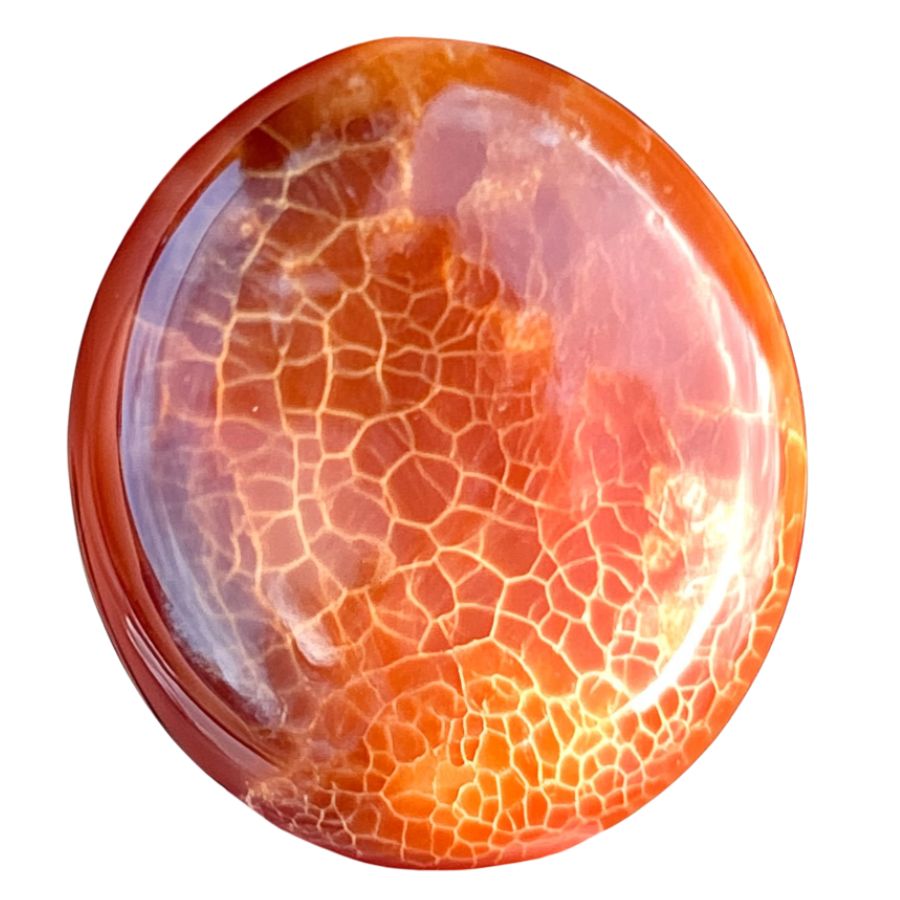
Orange Fire Agate shimmers with warm, sunset-like colors that seem to glow from within. The dominant orange tones mix with bright reds and yellows. These colors appear especially vibrant against the stone’s natural brown background.
The stone often shows interesting pattern formations that look like swirling flames or flowing liquid. These patterns form naturally during the stone’s creation and give each piece its own character.
A unique feature of Orange Fire Agate is its ability to show broad flashes of color. Instead of tiny specks, the color often appears in larger areas that create bold, dramatic effects.
The color layers in Orange Fire Agate often stack up in ways that create depth and dimension. When you look closely, you can see how these layers work together to produce the stone’s distinctive fire effect. The best pieces show clear, bright colors that remain visible from many different angles.
Yellow Fire Agate
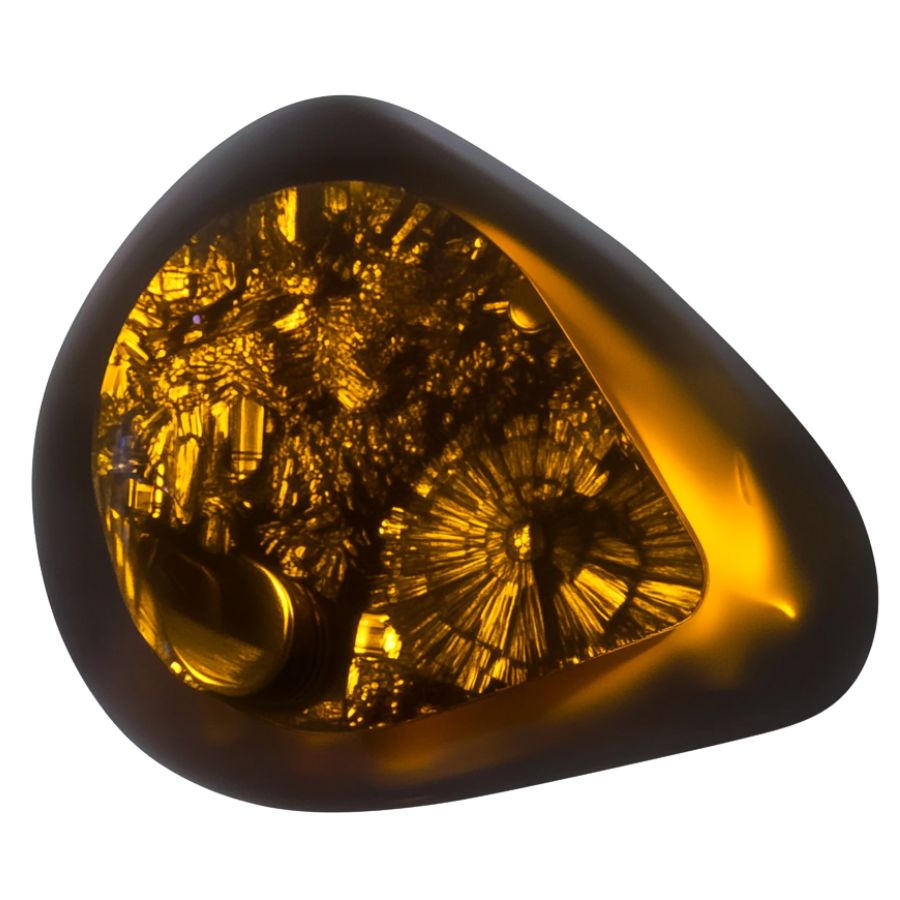
Yellow Fire Agate features bright, sunny yellow tones mixed with golden flashes that light up the stone. The yellow colors often appear alongside warm oranges and subtle greens, creating a bright, cheerful appearance.
Unlike other fire agates, the yellow variety often displays broader, more open patterns. This allows the yellow colors to spread out and create larger areas of bright color.
A special characteristic of Yellow Fire Agate is how its colors can shift between yellow and gold depending on the lighting. Sometimes, the stone shows unexpected flashes of green or blue, making it particularly interesting to observe.
The structure of Yellow Fire Agate often creates interesting patterns that look like sunbursts or radiating lines. These natural formations enhance the stone’s yellow tones and create fascinating visual effects.
Green Fire Agate
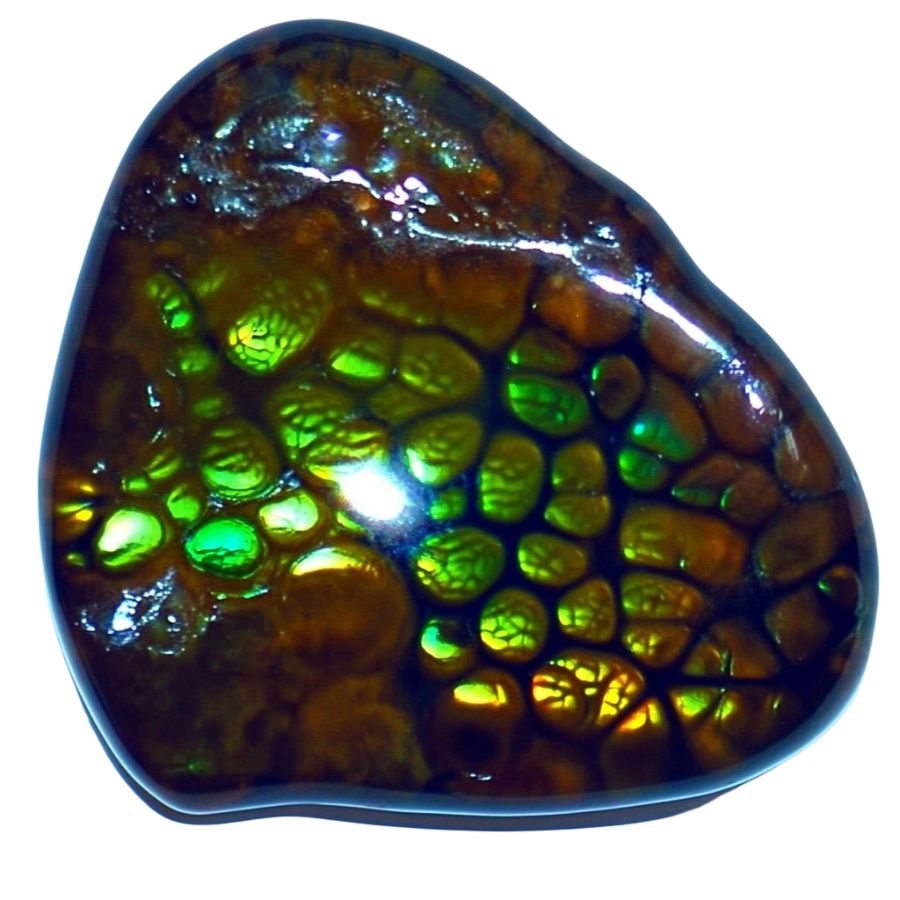
Green Fire Agate stands out with its unusual green flashes that sparkle against a dark background. This rare color combination creates an effect similar to the Northern Lights in miniature.
The green tones range from bright emerald to deep forest green, sometimes mixing with blue and turquoise highlights.
In natural sunlight, the greens become more vibrant and intense. Under artificial light, the stone might reveal subtle gold or blue undertones that weren’t visible before.
This stone sometimes shows an interesting phenomenon where the green fire appears to pulse or throb when the stone is moved. The combination of deep greens and shifting patterns creates a mesmerizing display that captivates viewers.
Peacock Fire Agate
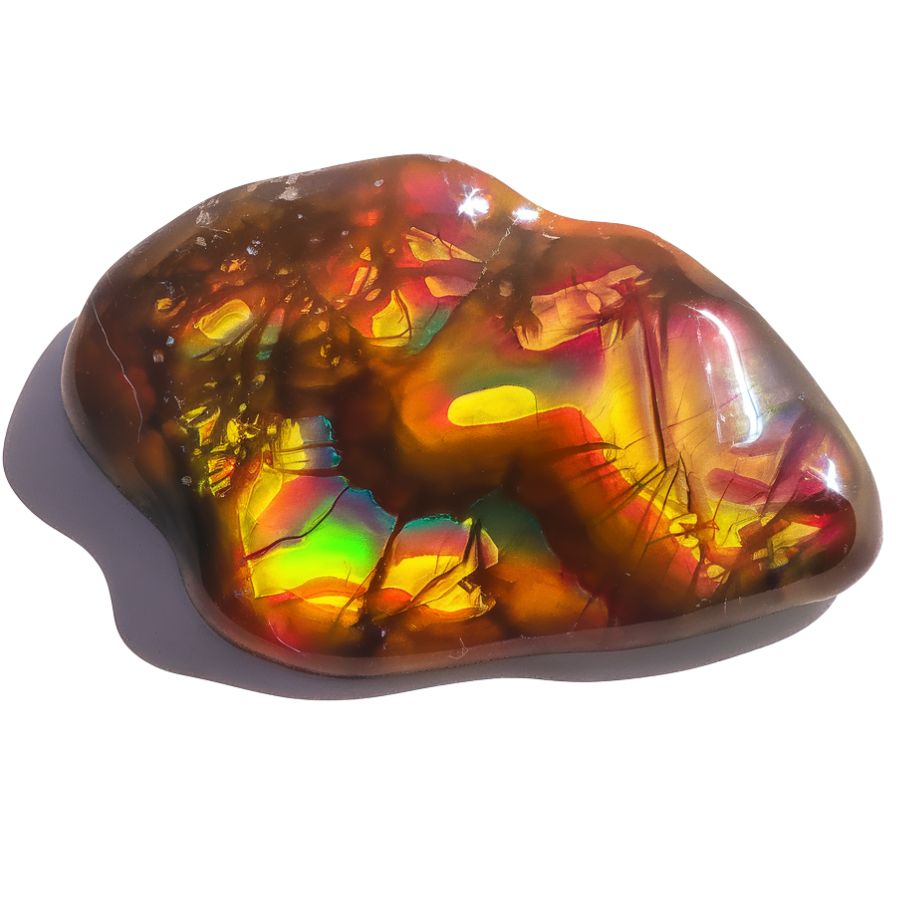
Peacock Fire Agate stands out for its remarkable display of iridescent colors that mirror a peacock’s feathers. The stone features bright greens, blues, and yellows that shimmer and change when viewed from different angles.
The stone’s surface has a unique grape-like structure called botryoidal formation. This creates small, rounded bumps across the surface that catch and reflect light in fascinating ways.
What makes this stone special is its ability to show three or more colors at once. While most fire agates display warm colors like orange and red, Peacock Fire Agate breaks this pattern with its cool, vibrant tones.
This variety requires skilled cutting to preserve its natural beauty. The cutting process must carefully consider the stone’s layers to maximize its color display and protect its delicate iridescent qualities. The end result is a stone that captures attention with its brilliant play of colors.
Crackled Fire Agate
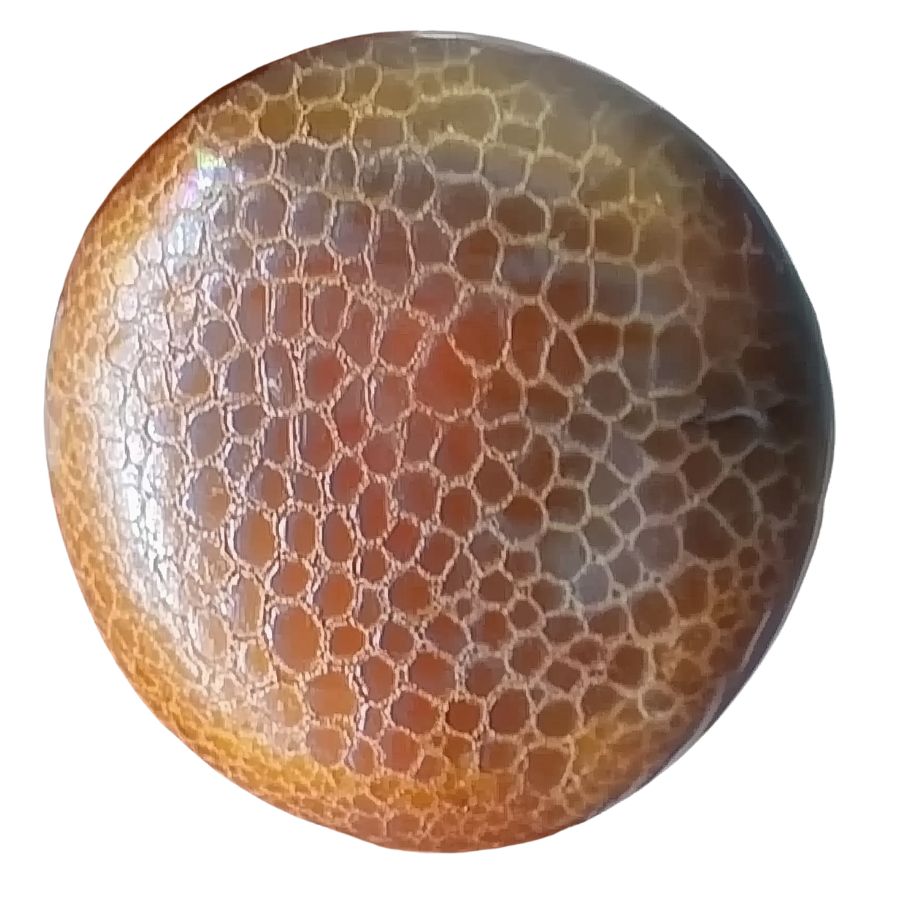
Crackled Fire Agate displays a deep reddish-brown base with bright flashes of orange, red, green, and gold. These colors create an effect that looks like flames trapped within the stone. The stone’s surface features a unique crackled pattern that resembles a spider’s web.
The stone gets its distinctive appearance through a special heat treatment process. The crackle effect adds depth and character to the stone’s natural fire-like appearance.
Unlike the uniform patterns seen in many stones, Crackled Fire Agate shows random, organic-looking designs. The combination of the crackled texture and the fire-like colors creates an impressive visual effect.
The complex internal structure of this stone makes it fascinating to observe. Light plays through the cracks and layers, creating an ever-changing display of colors. This interplay of light and pattern gives each stone its own personality and charm.
Mexican Fire Agate
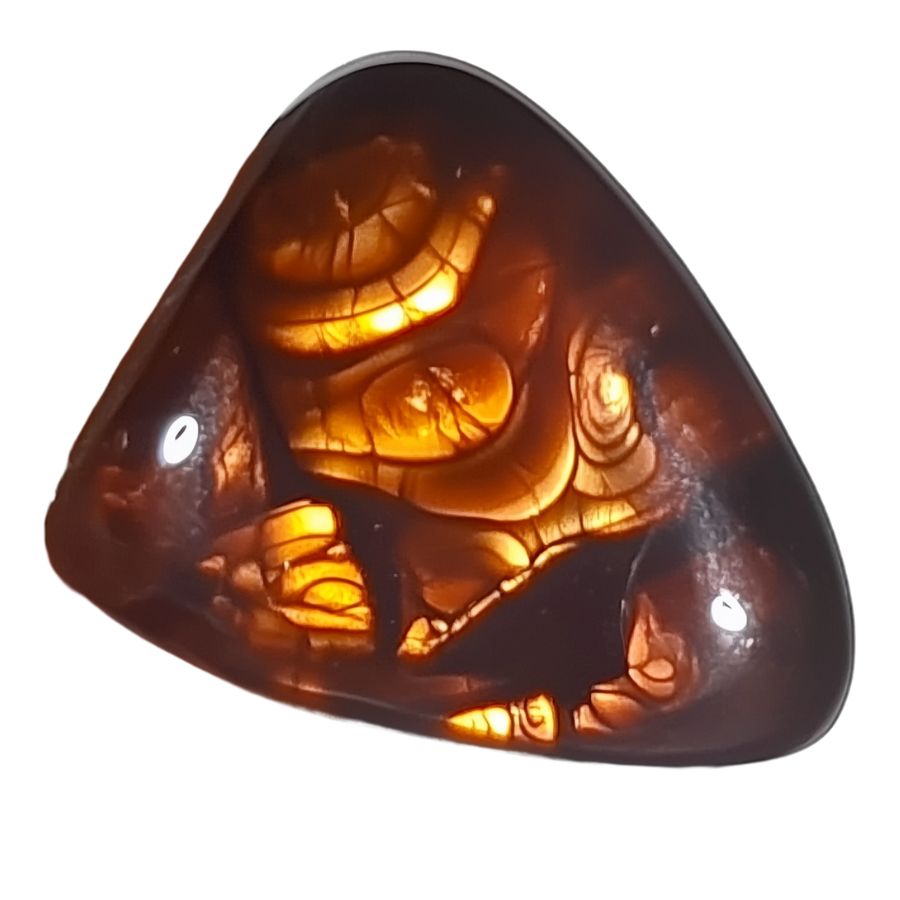
Mexican Fire Agate showcases brilliant flashes of color. The stone displays vivid reds, oranges, and yellows, with occasional hints of green and blue. These colors appear to move and shift within the stone, creating a dynamic visual effect.
The stone’s internal structure contains multiple thin layers that create its distinctive fire effect. These layers, built up over millions of years, catch and reflect light in unique ways.
Each piece of Mexican Fire Agate tells its own story through its pattern of colors. The stone’s surface often shows interesting textures and patterns that enhance its natural beauty. Some pieces display broad flashes of color, while others show intricate, detailed patterns.
The stone’s formation process gives it exceptional clarity and brightness. Unlike artificially enhanced stones, its beauty comes entirely from nature. .
Arizona Fire Agate
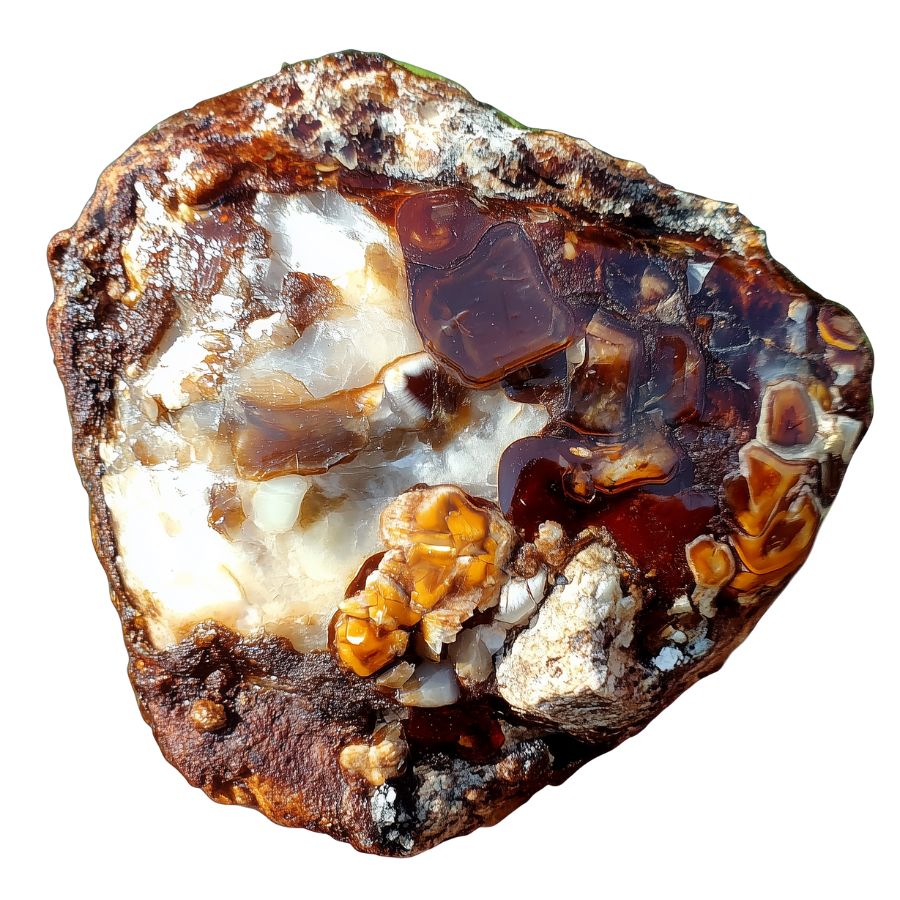
Arizona Fire Agate showcases a unique combination of a rich brown base with vibrant flashes of color. The stone’s distinguishing feature is its exceptional three-dimensional play of color, which appears to float within different layers.
It often shows stronger and more concentrated color patterns compared to other varieties. The fire effect typically appears in concentrated areas rather than spread throughout the stone.
This concentration creates dramatic focal points that catch the eye immediately. Many pieces display a distinct bull’s eye pattern where the colors radiate from a central point.
This stone is known for its durability and lasting color display. Unlike many other iridescent stones, its color effect doesn’t fade or diminish over time. The colors remain vivid even after years of exposure to light.
What Rough Fire Agate Looks Like
Here’s how you can identify a Fire Agate in its natural state.
Look for the Characteristic Brown Base Color
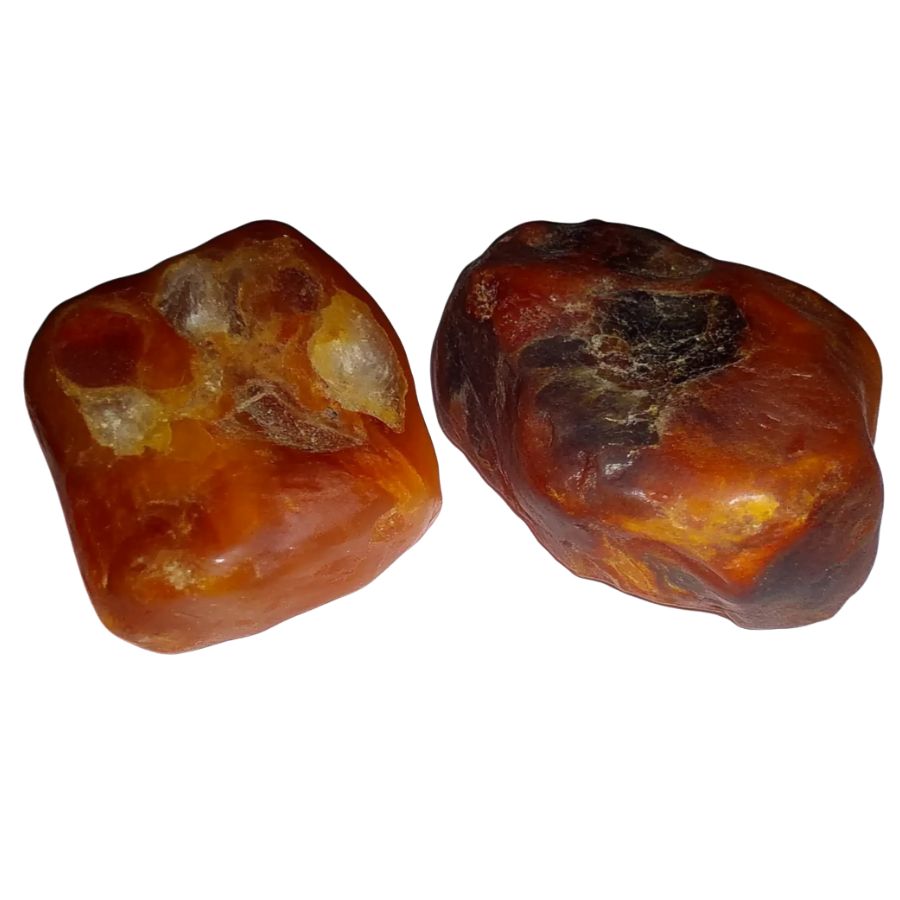
Raw fire agate typically shows up as a brownish-gray or reddish-brown nodule. Don’t expect the flashy colors right away! The base material looks pretty ordinary – like a dull, chocolate-colored rock.
Sometimes you’ll catch hints of that signature iridescence peeking through, especially in small cracks or worn areas.
Check for Botryoidal Surface Texture
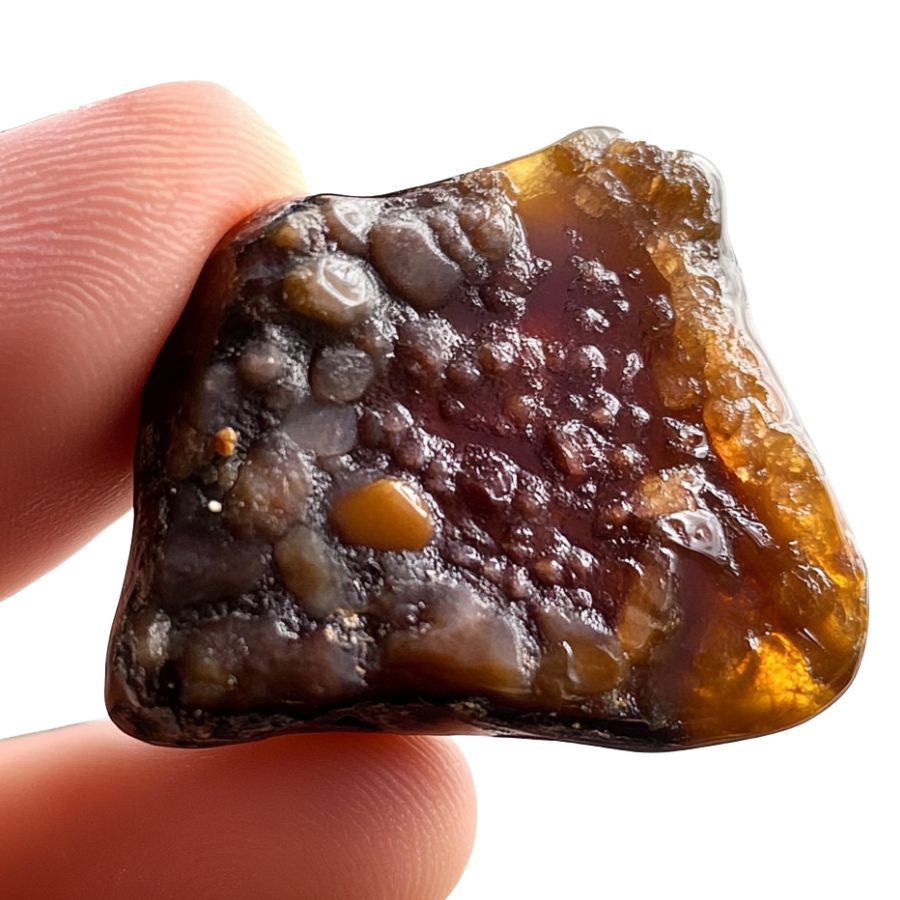
Run your fingers over the surface. Feel those grape-like bumps? That’s the botryoidal texture – a dead giveaway for fire agate.
These rounded bumps often cluster together, creating a bubbly surface that looks like frozen soap bubbles. Fresh pieces might have a crusty, rough coating hiding this texture.
Inspect for Color Play in Natural Light
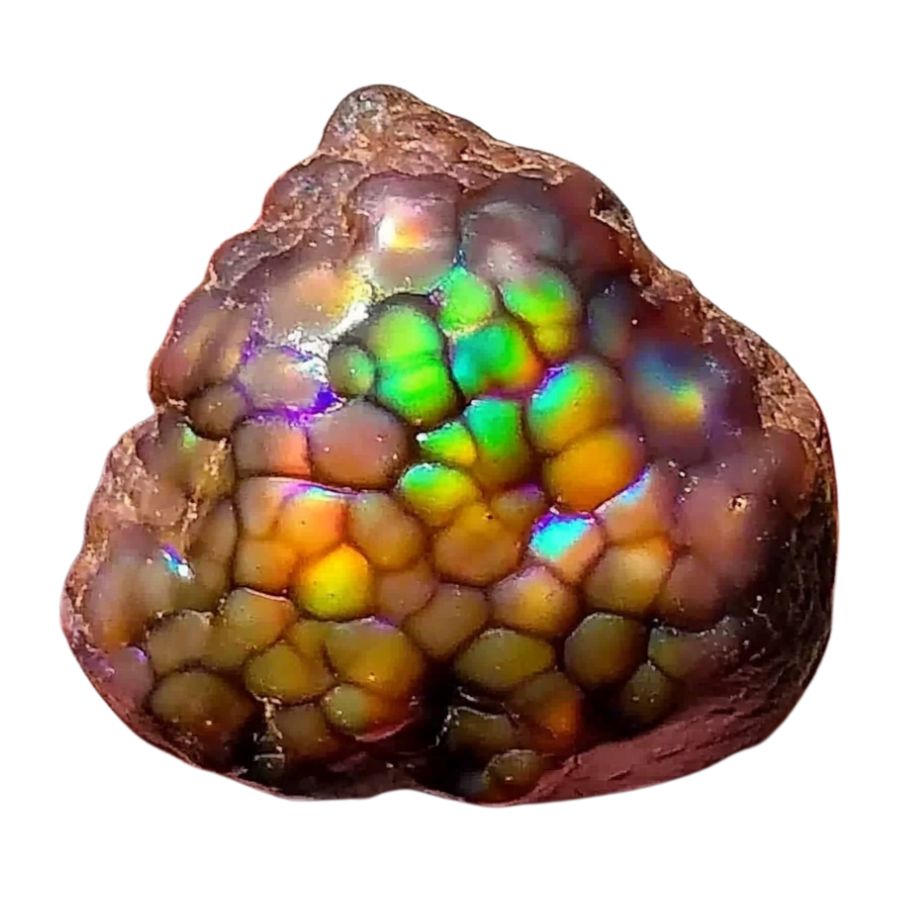
Hold the specimen under direct sunlight or bright light. Rotate it slowly. Look for flashes of green, gold, or red in small areas – especially where the surface is naturally worn.
These color flashes might be subtle in rough pieces, appearing like tiny windows of color.
Test the Chalcedony Properties
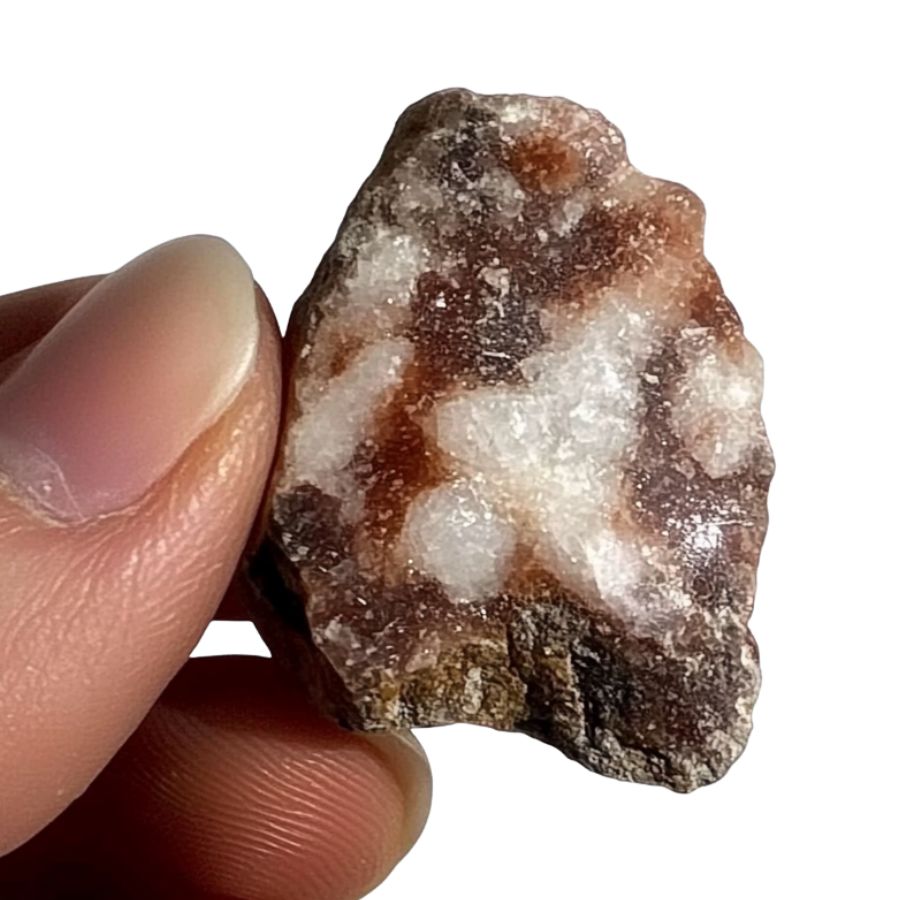
Fire agate is a variety of chalcedony, so it should feel quite solid and slightly warm to the touch. Try scratching it with a steel knife – it shouldn’t scratch easily.
The surface might show some waxy or glassy areas where the outer layer has worn away, revealing the chalcedony underneath.
Tips on Where to Look
Fire agate is found in areas with past volcanic activity. These beautiful stones typically form in volcanic regions where silica-rich solutions filled cavities in rocks. Here’s where you should start looking:
Volcanic Rock Formations
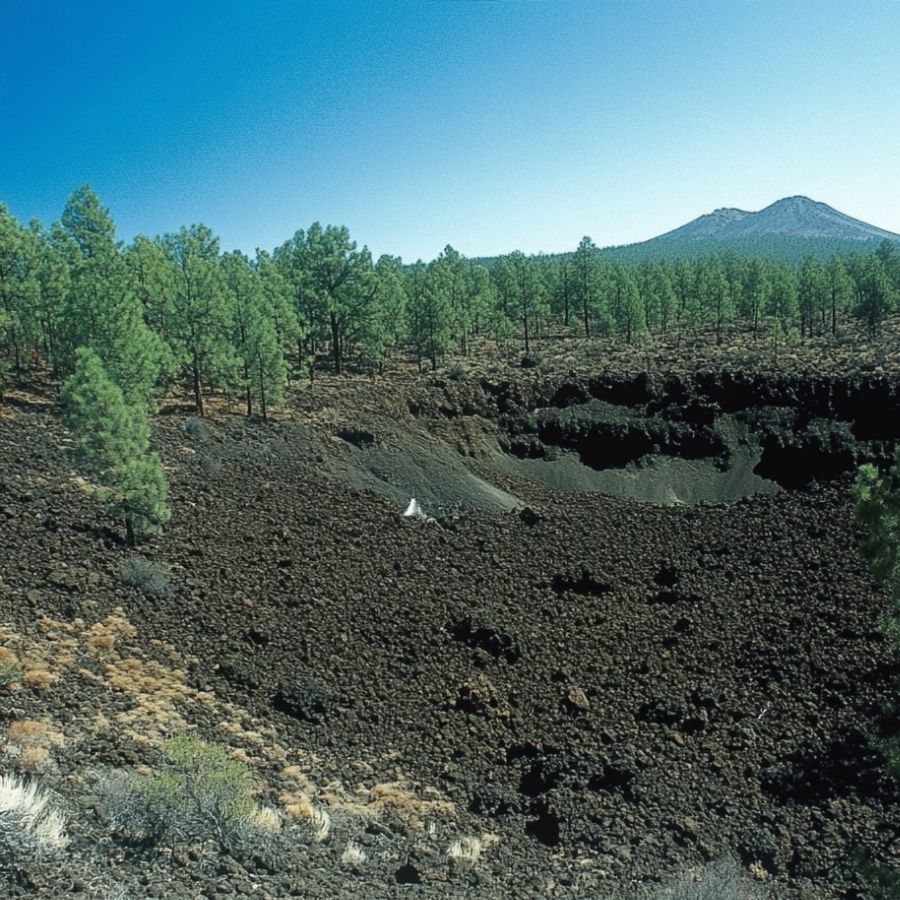
Look for areas with basalt or other volcanic rocks. The stone usually forms in gas pockets within these rocks. Check dark-colored, rough-textured rocks that seem bubbly or have lots of holes.
Areas where you spot chunks of obsidian are also promising, since both stones form in similar conditions.
Desert Washes and Dry Creek Beds
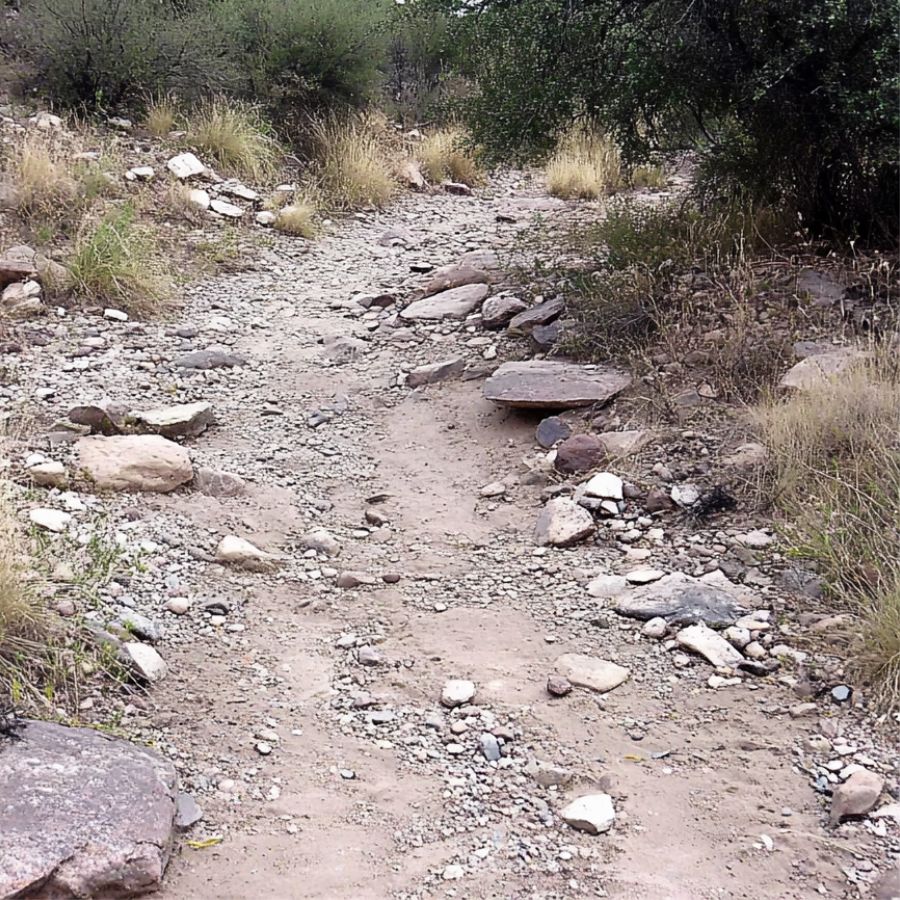
Search in dry creek beds that cut through volcanic areas. After rainstorms, these washes often expose new material and can reveal fire agate specimens that have weathered out of their host rock.
Keep an eye out for reddish-brown chunks with a waxy luster, which could be your target stone hiding under a chalcedony crust.
Old Mining Areas
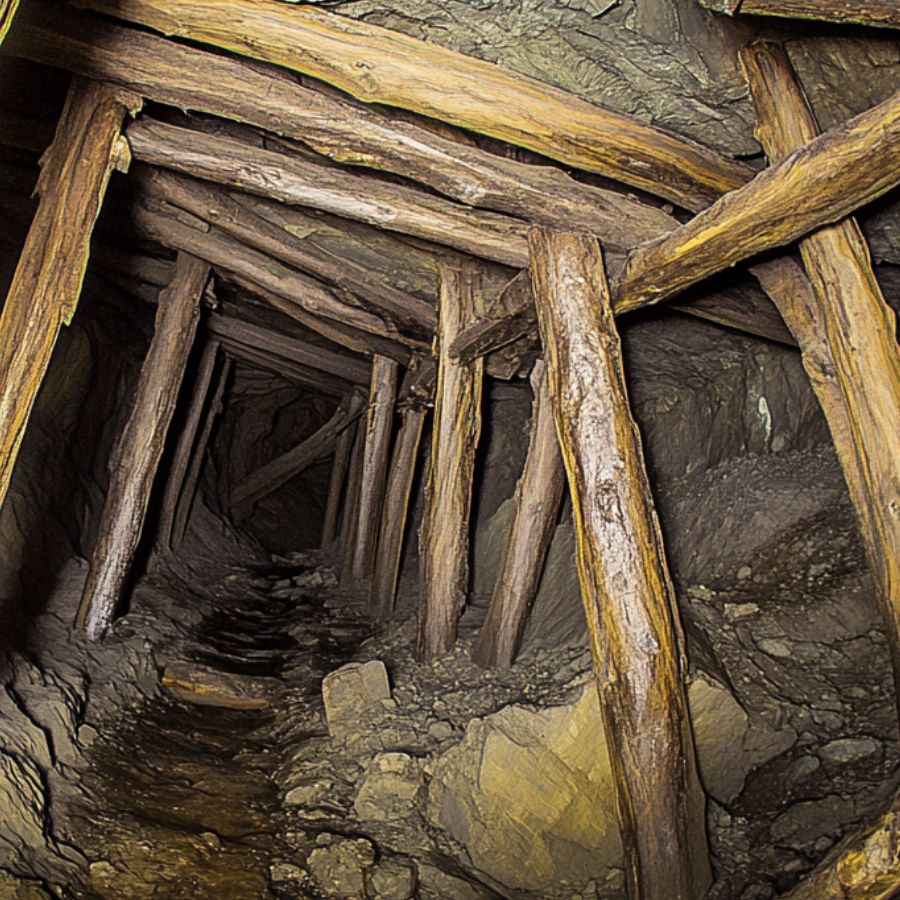
Check around abandoned mining districts, especially those known for copper minerals. Fire agate often occurs near copper deposits, so tailings piles and dumps from old mines can be great spots to search.
When you’re exploring these areas, look for rocks with a botryoidal (grape-like) surface texture and reddish-brown coloring, which are typical characteristics of fire agate’s outer appearance.
Hillside Slopes
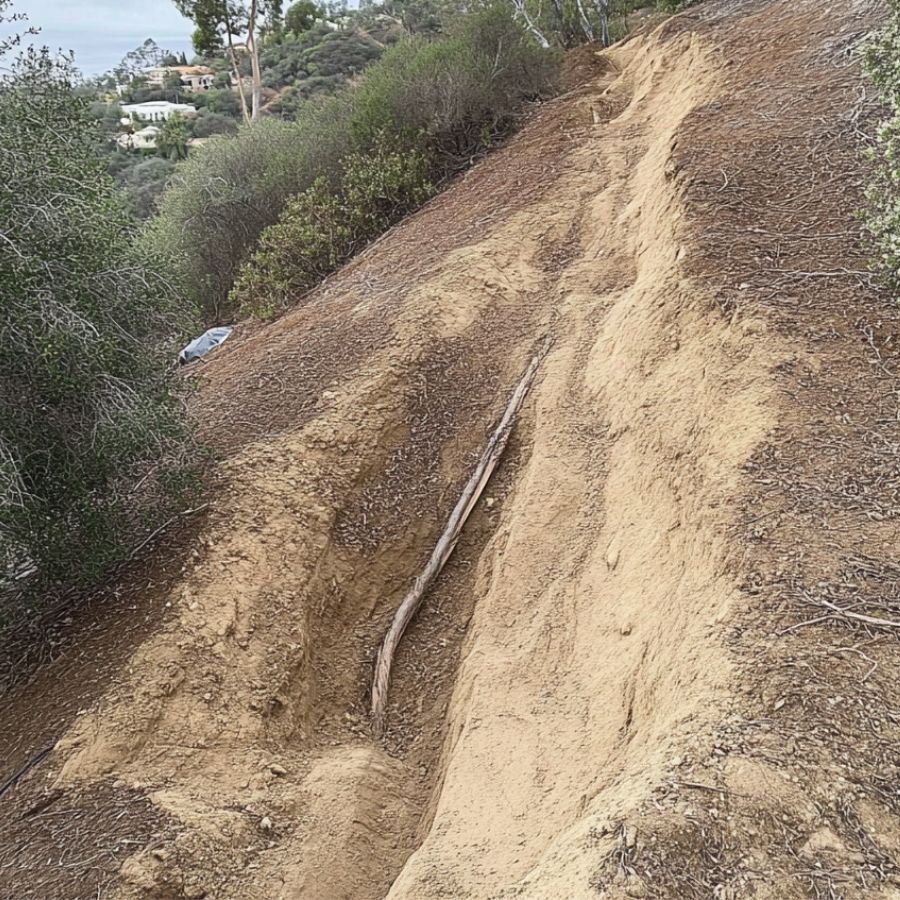
Explore gentle slopes below volcanic outcrops. As the host rock weathers, pieces of fire agate often roll downhill and collect along these slopes.
The best time to search these areas is after heavy rains have washed away loose soil and exposed new material, giving you a better chance of spotting the distinctive brown nodules that might contain fire agate.
Tools You Will Need
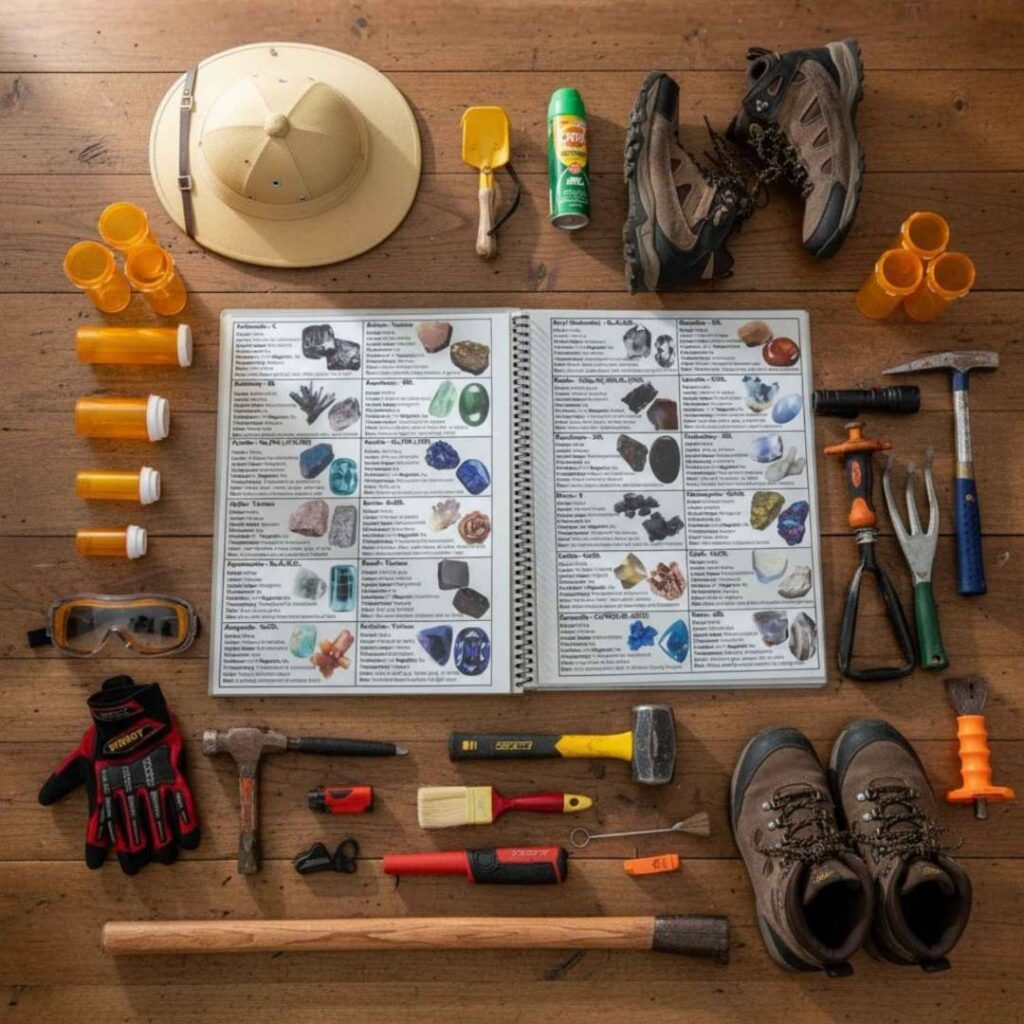
Fire agates can hide under dust, gravel, and loose desert rock, so having a few simple tools makes the search a lot easier. You don’t need a heavy kit to get started, just a handful of basics that help you dig, spot color, and keep your finds safe.
A Trustworthy Field Guide – Essential
Rock hounds in California deal with a huge range of rocks, minerals, and odd little surprises, and having a guide built for that variety saves a lot of time in the field.
Rock Chasing’s California Rocks & Minerals Identification Field Guide gives you clear photos, fast facts, and a simple layout that lets you identify more than 120 different finds at a glance.
The laminated, waterproof pages hold up to mud, creek spray, and dust, so you can actually use it outdoors without worrying about ruining it.
When you open your pack and compare a new find to the guide’s detailed images, you get answers quickly and avoid that feeling of walking right past something special.
Collectors appreciate the accurate data and crisp close-ups that make labeling and organizing finds much easier. Kids get drawn in by the bright photos and bite-sized facts, which makes it a great companion for family outings or school trips.
Hand Rake – Essential
A small hand rake helps you pull back loose sand and pebbles so you can spot the flashes of color that fire agates are known for. It gives you better control than a shovel and keeps you from scraping the stone by accident. Beginners will find it useful in almost every kind of rocky wash or desert hillside.
Bucket or Cloth Bag – Recommended
Fire agates can chip if they bounce around, so having a simple container keeps everything safe while you explore. A bucket works well for rough terrain, while a cloth bag is lighter for long walks. Either one makes collecting easier and keeps your pockets from filling with dust.
Soft Brush – Essential
A soft brush helps reveal color without damaging the stone. A quick sweep can remove dirt that hides the fire-like flashes inside the agate. It’s especially helpful in dry areas where dust clings to everything.
Spray Bottle – Optional
A small spray bottle of water can make colors pop when sunlight hits the stone. It’s not required, but it’s fun to use and can help you confirm whether you’ve found something worth taking home. It also cools you off on a warm day, which is a little bonus during long hunts.
Some Great Places To Start
Here are some of the better places in the state to start looking for fire agates:
Always Confirm Access and Collection Rules!
Before heading out to any of the locations on our list you need to confirm access requirements and collection rules for both public and private locations directly with the location. We haven’t personally verified every location and the access requirements and collection rules often change without notice.
Many of the locations we mention will not allow collecting but are still great places for those who love to find beautiful rocks and minerals in the wild without keeping them. We also can’t guarantee you will find anything in these locations since they are constantly changing.
Always get updated information directly from the source ahead of time to ensure responsible rockhounding. If you want even more current options it’s always a good idea to contact local rock and mineral clubs and groups
Mule Mountains
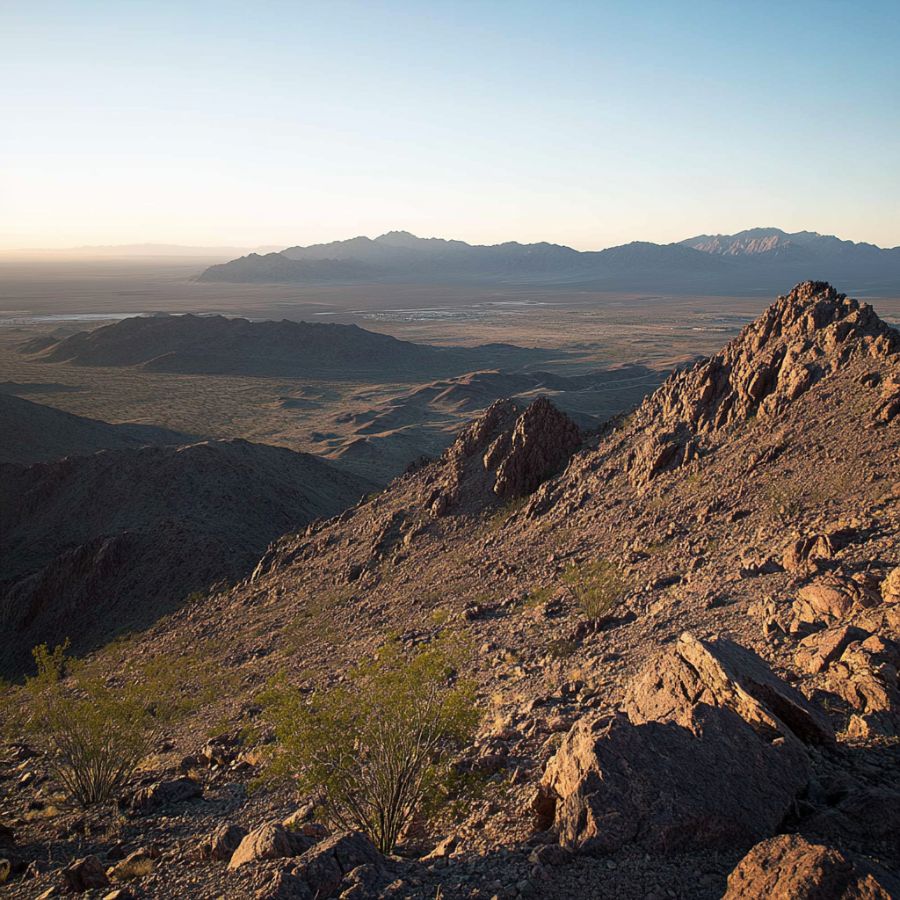
Mule Mountains stretch for 18 miles in southeastern California, just south of Interstate 10 in Riverside County. The range is home to the famous Opal Hill Mine, one of California’s best spots for finding fire agate.
Opal Hill mine sits in an area full of rocky outcrops where beautiful fire agates hide in chalcedony deposits. Many rockhounds have found high-quality fire agates here, some as big as a golf ball.
The best collecting spots are around the old mine workings, where you’ll find lots of spots to dig.
If your kids constantly ask “What’s this rock?”, this guide finally gives you an answer you don’t have to Google later. Quick photos, simple descriptions, and rugged pages make ID’ing rocks fun instead of frustrating.
🔍 Fast visual matching—no geology background needed
💦 Wipe-clean pages made for creeks, beaches & dirt
📚 Simple explanations for beginners of all ages
🌄 Great for California hikes, creek beds & camping trips
Blythe
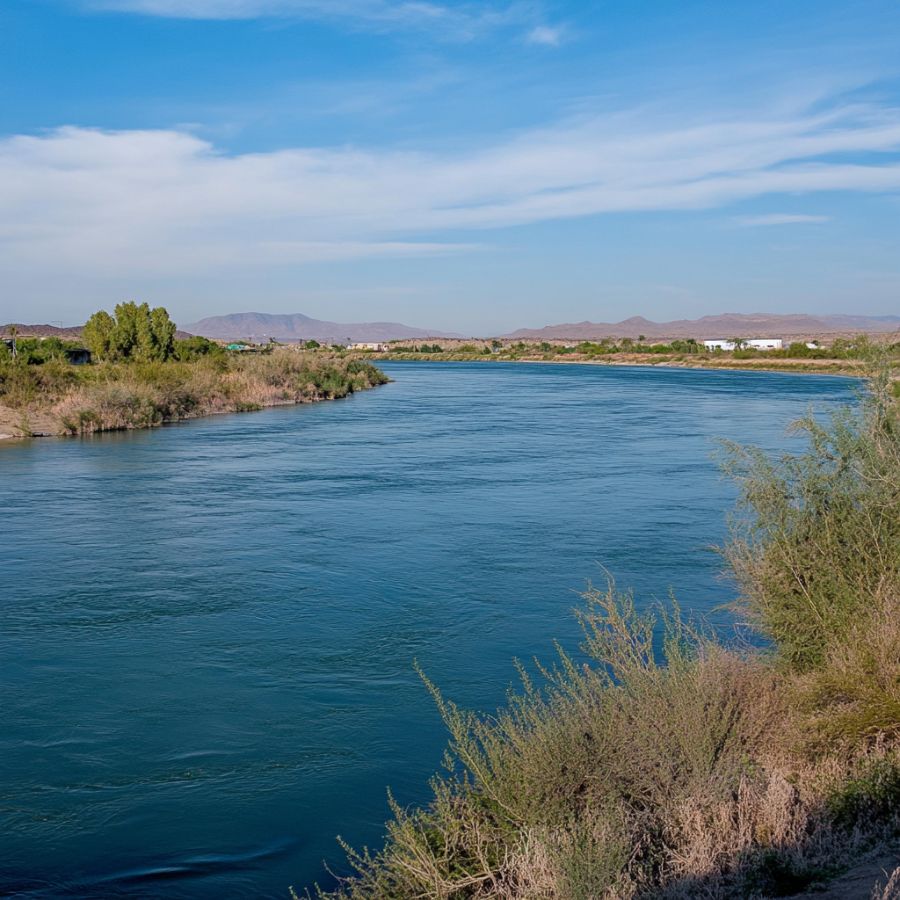
Blythe is located in southeastern California, right by the Arizona border along the Colorado River. The area is surrounded by five mountain ranges – the Big Maria, Little Maria, Riverside, McCoy, and Mule Mountains.
Many rockhounds have found fire agate here, often mixed with other stones like chalcedony and quartz crystals. The best spots to look are areas with exposed quartz veins.
Local geology makes Blythe special for gemstone hunting. The ground has layers of volcanic rock that formed when hot lava cooled down long ago. Fire agate typically forms in these volcanic areas.
Look for reddish-brown or orange rocks with rough surfaces – they might hide beautiful fire agate inside.
Black Hills
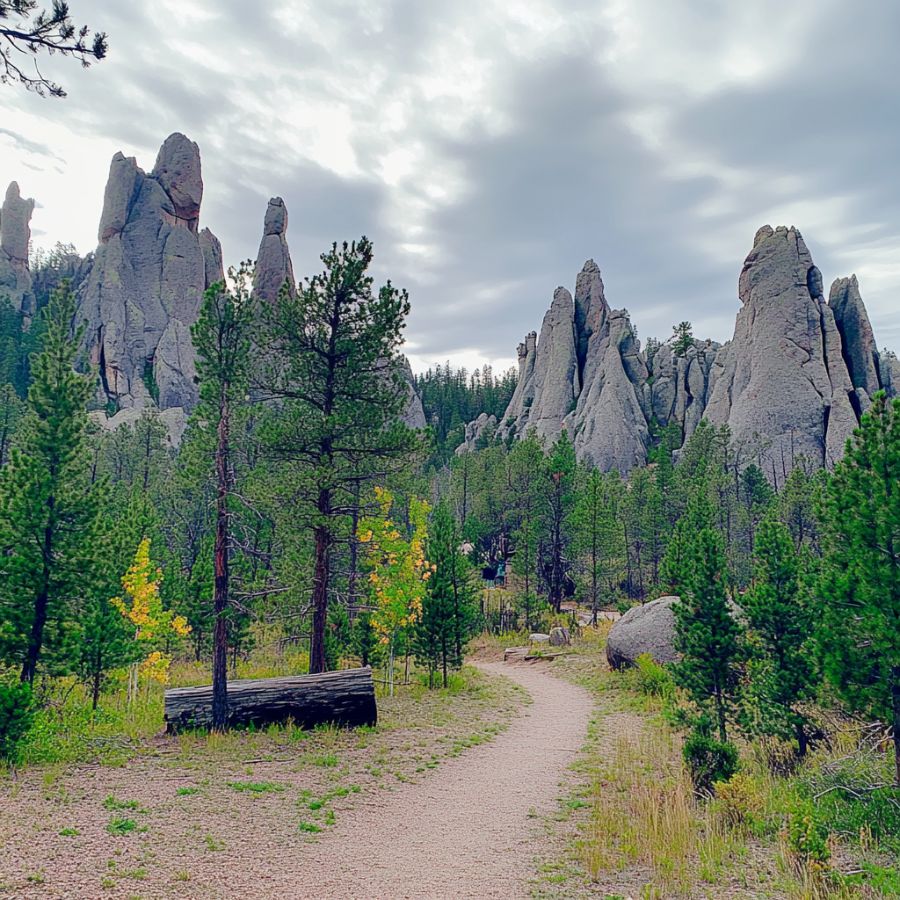
The Black Hills rise from the Colorado Desert in Imperial County, California. This rocky mountain range reaches 1,345 feet high and has become famous among rock collectors.
The area holds three well-known spots for finding gems: the Hauser Geode Beds, Hidden Saddle Beds, and Straw Beds.
Fire agate shows up in places where old volcanic activity left its mark. Rock hunters often find them near the surface, mixed with other stones like brown jasper and black agate.
Many collectors visit this spot because it has both fire agate and picture sandstone with pretty cream and orange patterns. The desert climate has helped break down rocks over time, making it easier to find gems.
Kramer Hills
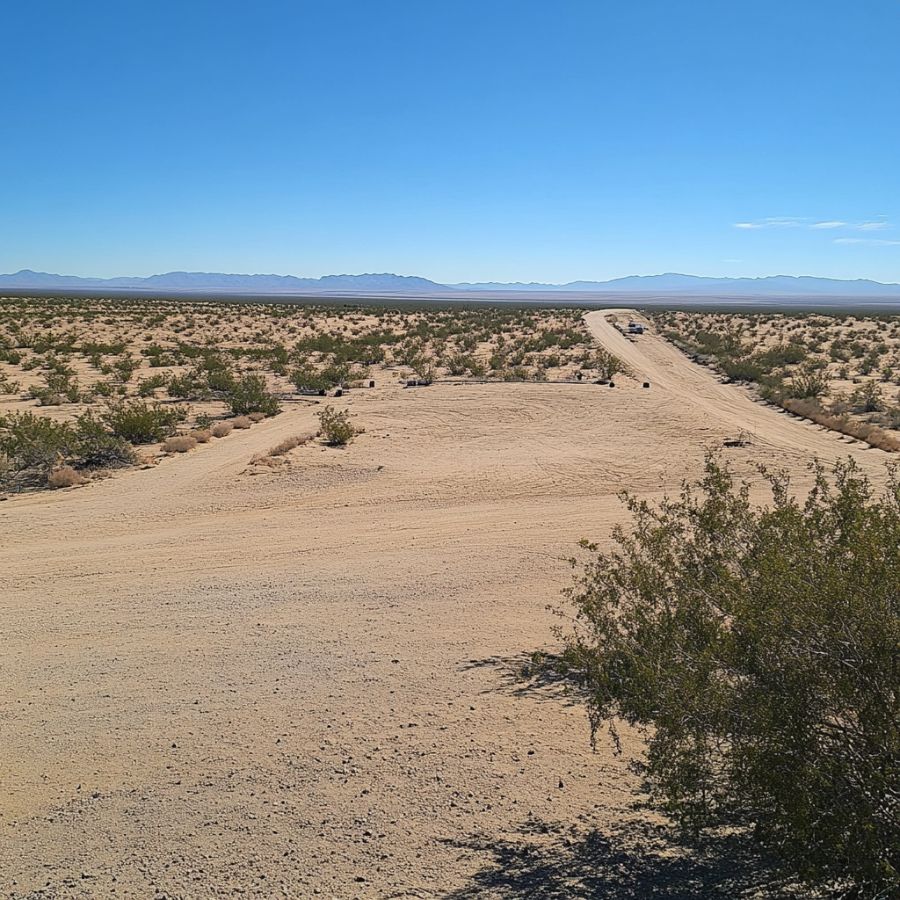
Kramer Hills sits in the Mojave Desert of San Bernardino County, California. You can find these small hills just south of Kramer Junction, where highways 395 and 58 meet. The area’s desert landscape makes it a good spot for rock collectors.
The hills show off typical Mojave Desert rock formations. Many collectors visit this area to search for different types of minerals and rocks. Promising spots to look for fire agate are along the areas where Highway 395 cuts through the hills.
Rock hunters often check the ground near the base of hills after rain, when stones are easier to spot.
Looking around the slopes and washes can lead to good finds. During cooler months, collectors walk the gentle slopes checking loose rocks and gravel areas. Many visitors also find interesting jasper and chalcedony specimens in this area.
Places Fire Agate has been found by County
After discussing our top picks, we wanted to discuss the other places on our list. Below is a list of the additional locations along with a breakdown of each place by county.
| County | Location |
| Riverside | Chuckwalla Mountains |
| Riverside | Palen Mountains |
| Imperial | Cargo Muchacho Mountains |
| Imperial | Picacho State Recreation Area |
| Imperial | Salton Sea Area |
| Imperial | Fish Creek Mountains |
| Imperial | Yuha Desert |
| San Diego | Borrego Springs |
| San Diego | Anza-Borrego Desert |
| San Diego | Carrizo Badlands |

